%%%%%%%%%%%%%%%%%%%%%%%%%%%%%%%%%%%%%%%%%%%%%%%%%%%%%%%%%%%%%%%%%%%%%
%%%
%
%
heterogeneous wireless sensor
% SEP: A Stable Election Protocol for clustered
%
networks
%
%
%
% (c) Georgios
Smaragdakis
%
% WING group, Computer Science Department, Boston University
%
%
% You can find full documentation and related information at:
%
http://csr.bu.edu/sep
%
%
%
% To report your comment or any bug please send e-mail to:
%
gsmaragd@cs.bu.edu
%
%
%
%
%
%
%
%%%%%%%%%%%%%%%%%%%%%%%%%%%%%%%%%%%%%%%%%%%%%%%%%%%%%%%%%%%%%%%%%%%%%
%%%
%%%%%%%%%%%%%%%%%%%%%%%%%%%%%%%%%%%%%%%%%%%%%%%%%%%%%%%%%%%%%%%%%%%%%
%%%
%
%
% This is the LEACH [1] code we have used.
% The same code can be used for FAIR if m=1
%
%
%
%
"An application-specific protocol architecture for
% [1] W.R.Heinzelman, A.P.Chandrakasan and
H.Balakrishnan,
%
wireless
%
networks"
microsensor
%
%
%
�
IEEE Transactions on Wireless Communications,
%
1(4):660-670,2002
%
%
%
%%%%%%%%%%%%%%%%%%%%%%%%%%%%%%%%%%%%%%%%%%%%%%%%%%%%%%%%%%%%%%%%%%%%%
%%%
clear;
%%%%%%%%%%%%%%%%%%%%%%%%%%%%%%%%
PARAMETERS %%%%%%%%%%%%%%%%%%%%%%%%%%%%
%Field Dimensions - x and y maximum (in meters)
xm=100;
ym=100;
%x and y Coordinates of the Sink
sink.x=0.5*xm;
sink.y=0.5*ym;
%Number of Nodes in the field
n=100
%Optimal Election Probability of a node
%to become cluster head
p=0.1;
%Energy Model (all values in Joules)
%Initial Energy
Eo=0.5;
%Eelec=Etx=Erx
ETX=50*0.000000001;
ERX=50*0.000000001;
%Transmit Amplifier types
Efs=10*0.000000000001;
Emp=0.0013*0.000000000001;
%Data Aggregation Energy
EDA=5*0.000000001;
%Values for Hetereogeneity
%Percentage of nodes than are advanced
m=0.1;
%\alpha
a=1;
�
%maximum number of rounds
rmax=9999
%%%%%%%%%%%%%%%%%%%%%%%%% END OF PARAMETERS %%%%%%%%%%%%%%%%%%%%%%%%
%Computation of do
do=sqrt(Efs/Emp);
%Creation of the random Sensor Network
figure(1);
for i=1:1:n
S(i).xd=rand(1,1)*xm;
XR(i)=S(i).xd;
S(i).yd=rand(1,1)*ym;
YR(i)=S(i).yd;
S(i).G=0;
%initially there are no cluster heads only nodes
S(i).type='N';
temp_rnd0=i;
%Random Election of Normal Nodes
if (temp_rnd0>=m*n+1)
S(i).E=Eo;
S(i).ENERGY=0;
plot(S(i).xd,S(i).yd,'o');
hold on;
end
%Random Election of Advanced Nodes
if (temp_rnd0
%counter for CHs
countCHs=0;
%counter for CHs per round
rcountCHs=0;
cluster=1;
countCHs;
rcountCHs=rcountCHs+countCHs;
flag_first_dead=0;
for r=0:1:rmax
r
%Operation for epoch
if(mod(r, round(1/p) )==0)
for i=1:1:n
S(i).G=0;
S(i).cl=0;
end
end
hold off;
%Number of dead nodes
dead=0;
%Number of dead Advanced Nodes
dead_a=0;
%Number of dead Normal Nodes
dead_n=0;
%counter for bit transmitted to Bases Station and to Cluster Heads
packets_TO_BS=0;
packets_TO_CH=0;
%counter for bit transmitted to Bases Station and to Cluster Heads
%per round
PACKETS_TO_CH(r+1)=0;
PACKETS_TO_BS(r+1)=0;
figure(1);
for i=1:1:n
%checking if there is a dead node
if (S(i).E<=0)
�
plot(S(i).xd,S(i).yd,'red .');
dead=dead+1;
if(S(i).ENERGY==1)
dead_a=dead_a+1;
end
if(S(i).ENERGY==0)
dead_n=dead_n+1;
end
hold on;
end
if S(i).E>0
S(i).type='N';
if (S(i).ENERGY==0)
plot(S(i).xd,S(i).yd,'o');
end
if (S(i).ENERGY==1)
plot(S(i).xd,S(i).yd,'+');
end
hold on;
end
end
plot(S(n+1).xd,S(n+1).yd,'x');
STATISTICS(r+1).DEAD=dead;
DEAD(r+1)=dead;
DEAD_N(r+1)=dead_n;
DEAD_A(r+1)=dead_a;
%When the first node dies
if (dead==1)
if(flag_first_dead==0)
first_dead=r
flag_first_dead=1;
end
end
countCHs=0;
cluster=1;
for i=1:1:n
if(S(i).E>0)
temp_rand=rand;
if ( (S(i).G)<=0)
�
%Election of Cluster Heads
if(temp_rand<= (p/(1-p*mod(r,round(1/p)))))
countCHs=countCHs+1;
packets_TO_BS=packets_TO_BS+1;
PACKETS_TO_BS(r+1)=packets_TO_BS;
S(i).type='C';
S(i).G=round(1/p)-1;
C(cluster).xd=S(i).xd;
C(cluster).yd=S(i).yd;
plot(S(i).xd,S(i).yd,'k*');
distance=sqrt( (S(i).xd-(S(n+1).xd) )^2 +
(S(i).yd-(S(n+1).yd) )^2 );
C(cluster).distance=distance;
C(cluster).id=i;
X(cluster)=S(i).xd;
Y(cluster)=S(i).yd;
cluster=cluster+1;
%Calculation of Energy dissipated
distance;
if (distance>do)
Emp*4000*( distance*distance*distance*distance ));
S(i).E=S(i).E- ( (ETX+EDA)*(4000) +
end
if (distance<=do)
Efs*4000*( distance * distance ));
S(i).E=S(i).E- ( (ETX+EDA)*(4000)
+
end
end
end
end
end
STATISTICS(r+1).CLUSTERHEADS=cluster-1;
CLUSTERHS(r+1)=cluster-1;
%Election of Associated Cluster Head for Normal Nodes
for i=1:1:n
if ( S(i).type=='N' && S(i).E>0 )
if(cluster-1>=1)
min_dis=sqrt( (S(i).xd-S(n+1).xd)^2 + (S(i).yd-S(n+1).yd)^2 );
�
min_dis_cluster=1;
for c=1:1:cluster-1
temp=min(min_dis,sqrt( (S(i).xd-C(c).xd)^2 +
(S(i).yd-C(c).yd)^2 ) );
if ( tempdo)
S(i).E=S(i).E- ( ETX*(4000) + Emp*4000*( min_dis *
min_dis * min_dis * min_dis));
end
if (min_dis<=do)
S(i).E=S(i).E- ( ETX*(4000) + Efs*4000*( min_dis *
min_dis));
end
%Energy dissipated
if(min_dis>0)
S(C(min_dis_cluster).id).E = S(C(min_dis_cluster).id).E-
( (ERX + EDA)*4000 );
PACKETS_TO_CH(r+1)=n-dead-cluster+1;
end
S(i).min_dis=min_dis;
S(i).min_dis_cluster=min_dis_cluster;
end
end
end
hold on;
countCHs;
rcountCHs=rcountCHs+countCHs;
%Code for Voronoi Cells
%Unfortynately if there is a small
%number of cells, Matlab's voronoi
%procedure has some problems
�
%[vx,vy]=voronoi(X,Y);
%plot(X,Y,'r*',vx,vy,'b-');
% hold on;
% voronoi(X,Y);
% axis([0 xm 0 ym]);
end
%%%%%%%%%%%%%%%%%%%%%%%%%%%%%%%%%%%
STATISTICS
%
%%%%%%%%%%%%%%%%%%%%%%%%%%%%%%%%%%%
%
: a rmax x 1 array of number of dead nodes/round
DEAD
DEAD_A : a rmax x 1 array of number of dead Advanced nodes/round
DEAD_N : a rmax x 1 array of number of dead Normal nodes/round
CLUSTERHS : a rmax x 1 array of number of Cluster Heads/round
PACKETS_TO_BS : a rmax x 1 array of number packets send to Base
%
%
%
%
%
Station/round
%
ClusterHeads/round
%
%
PACKETS_TO_CH : a rmax x 1 array of number of packets send to
first_dead: the round where the first node died
%
%%%%%%%%%%%%%%%%%%%%%%%%%%%%%%%%%%%%%%%%%%%%%%%%%%%%%%%%%%%%%%%%%%%%%
%%%%%%%%%%%%%%%%%%
�
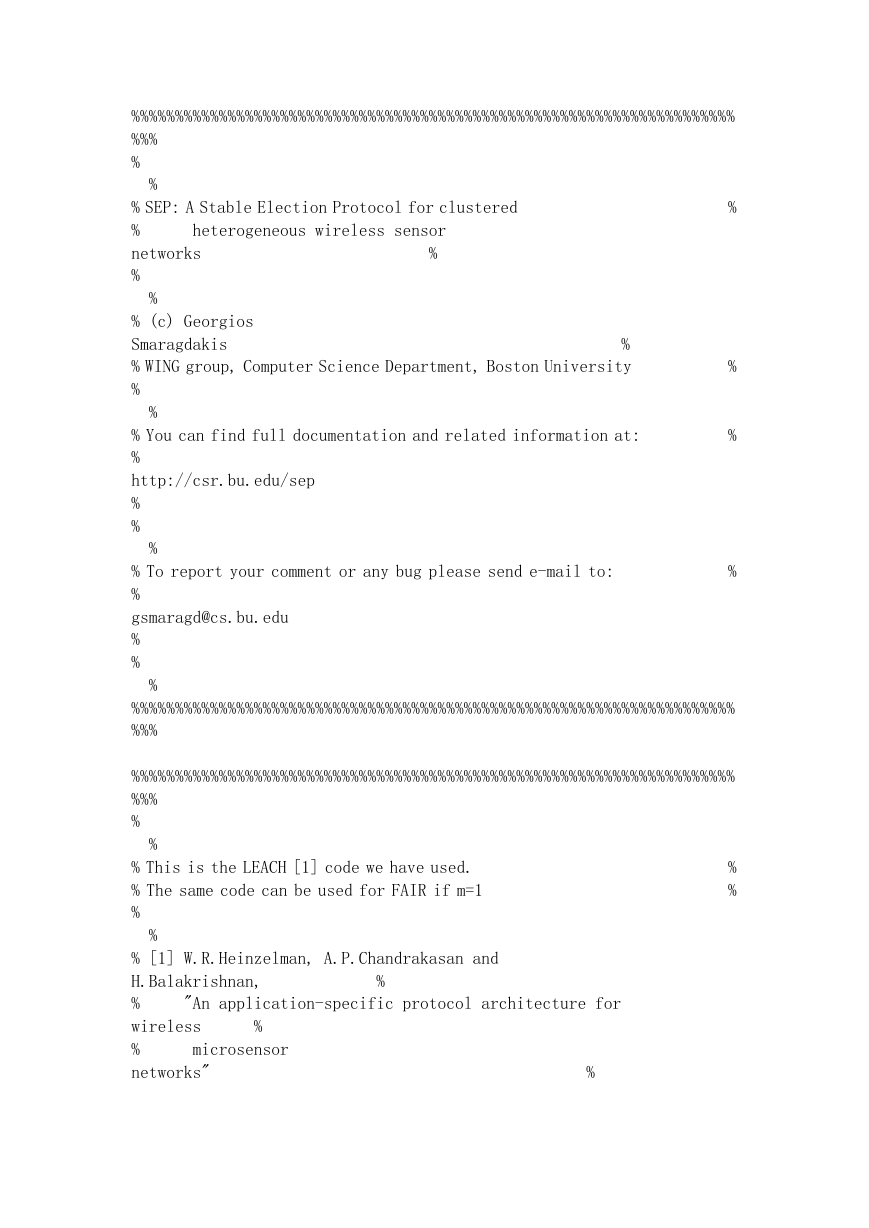
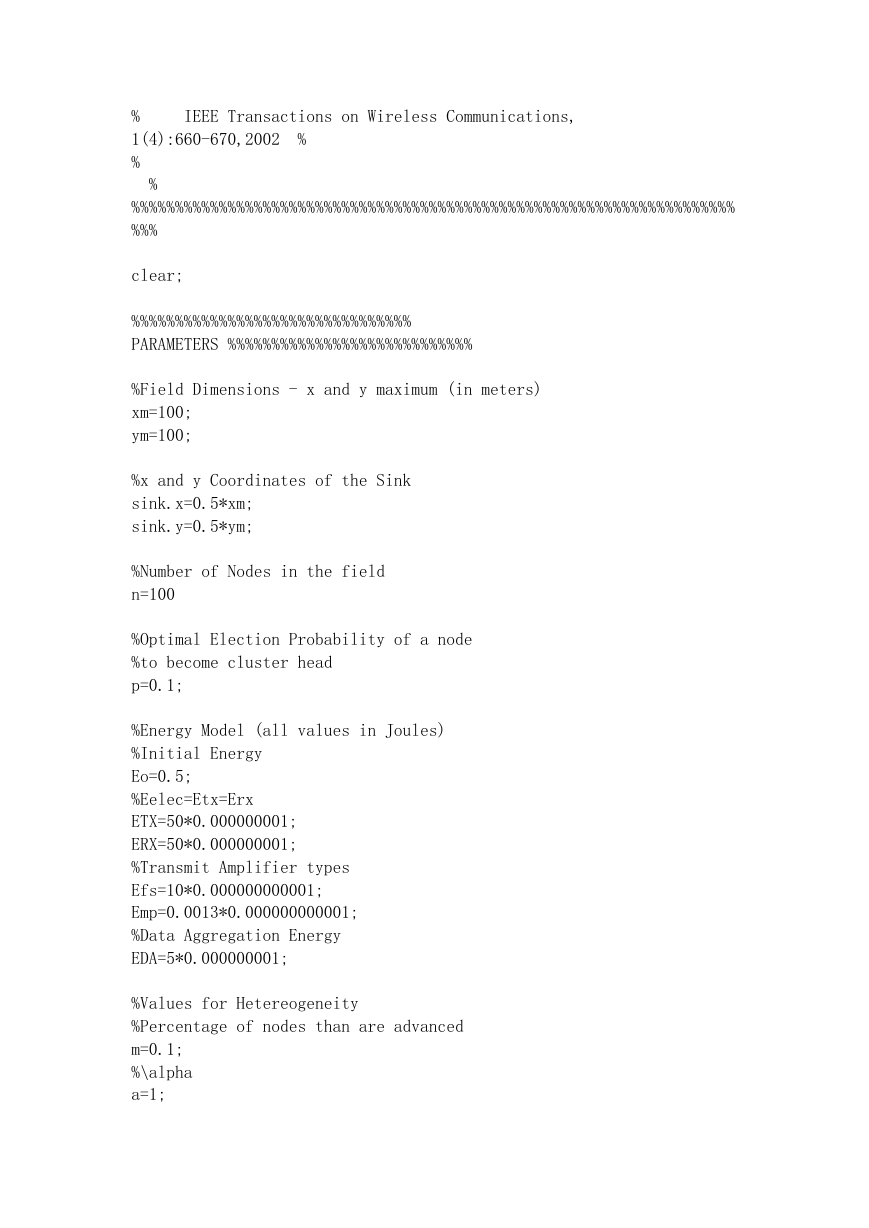
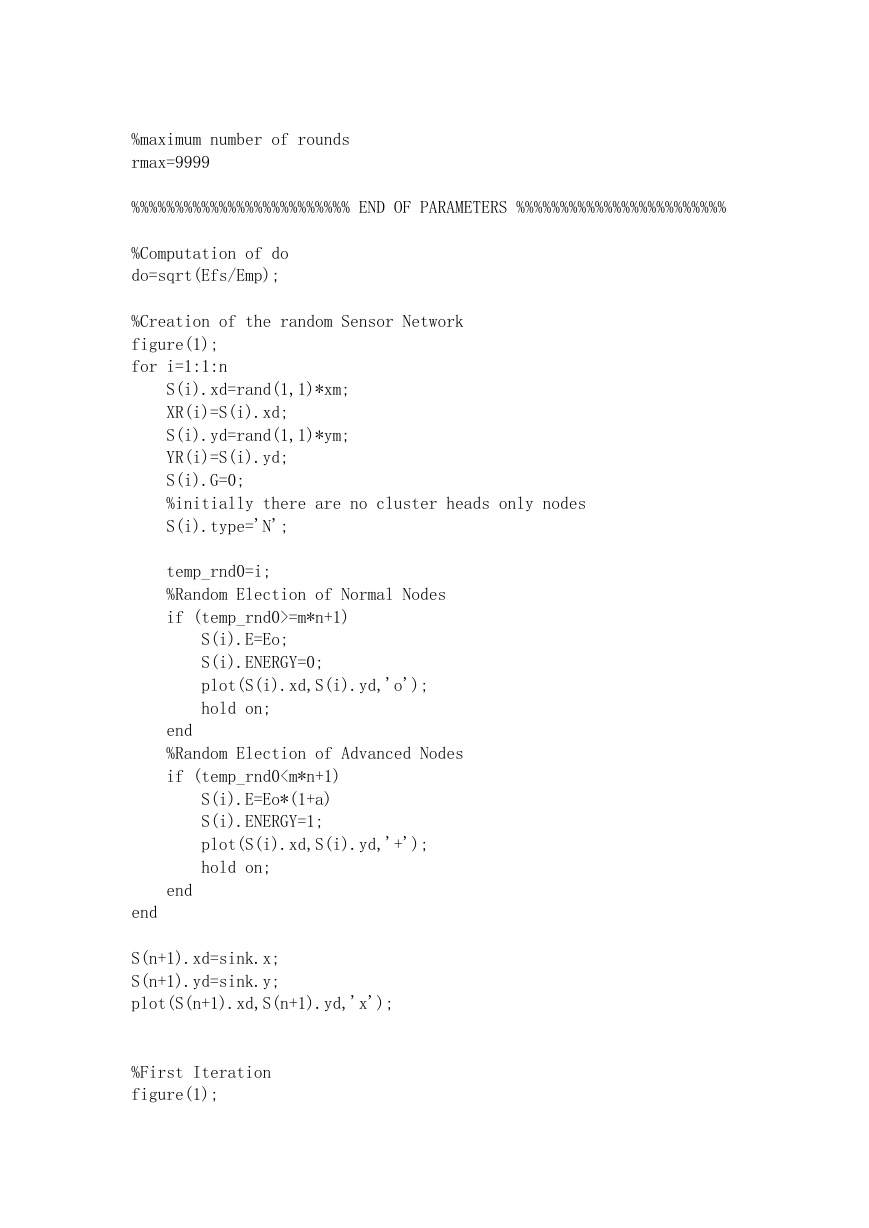

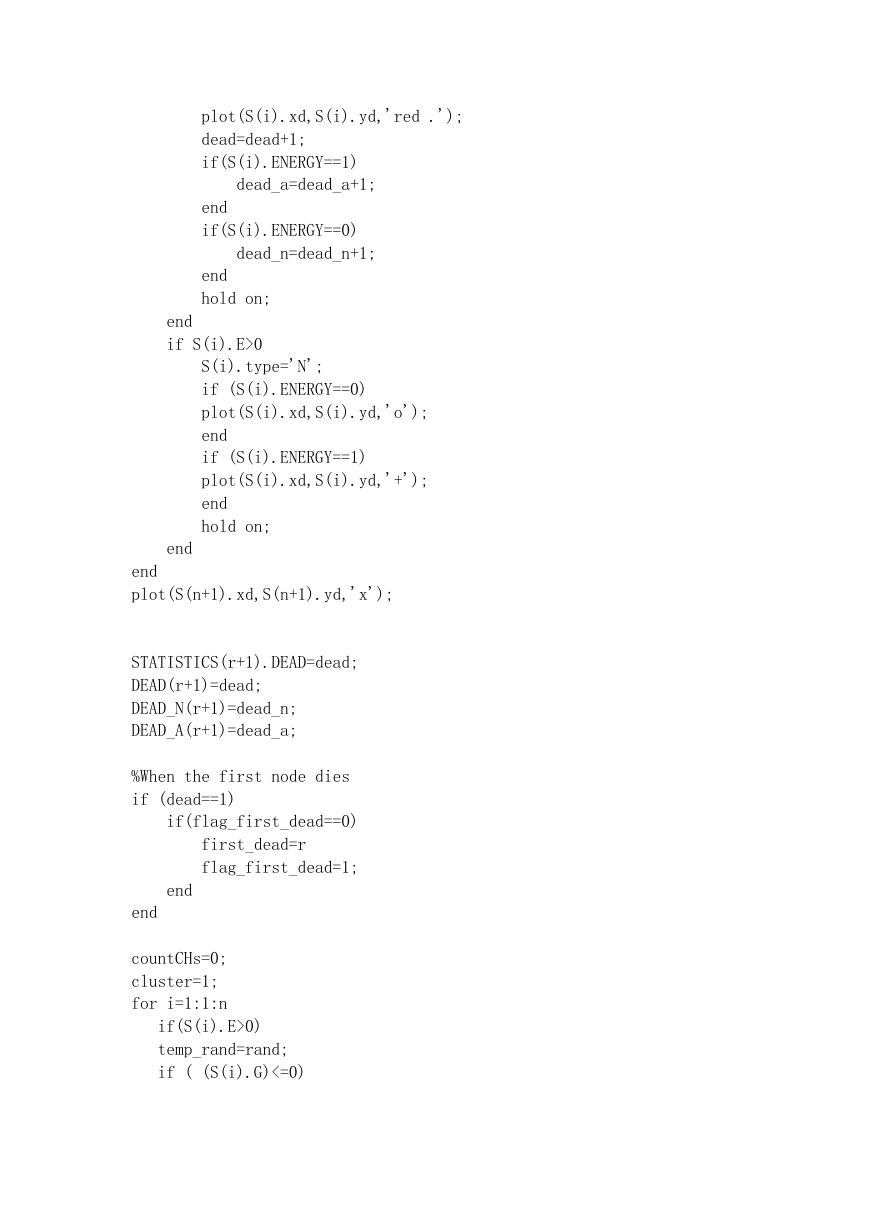

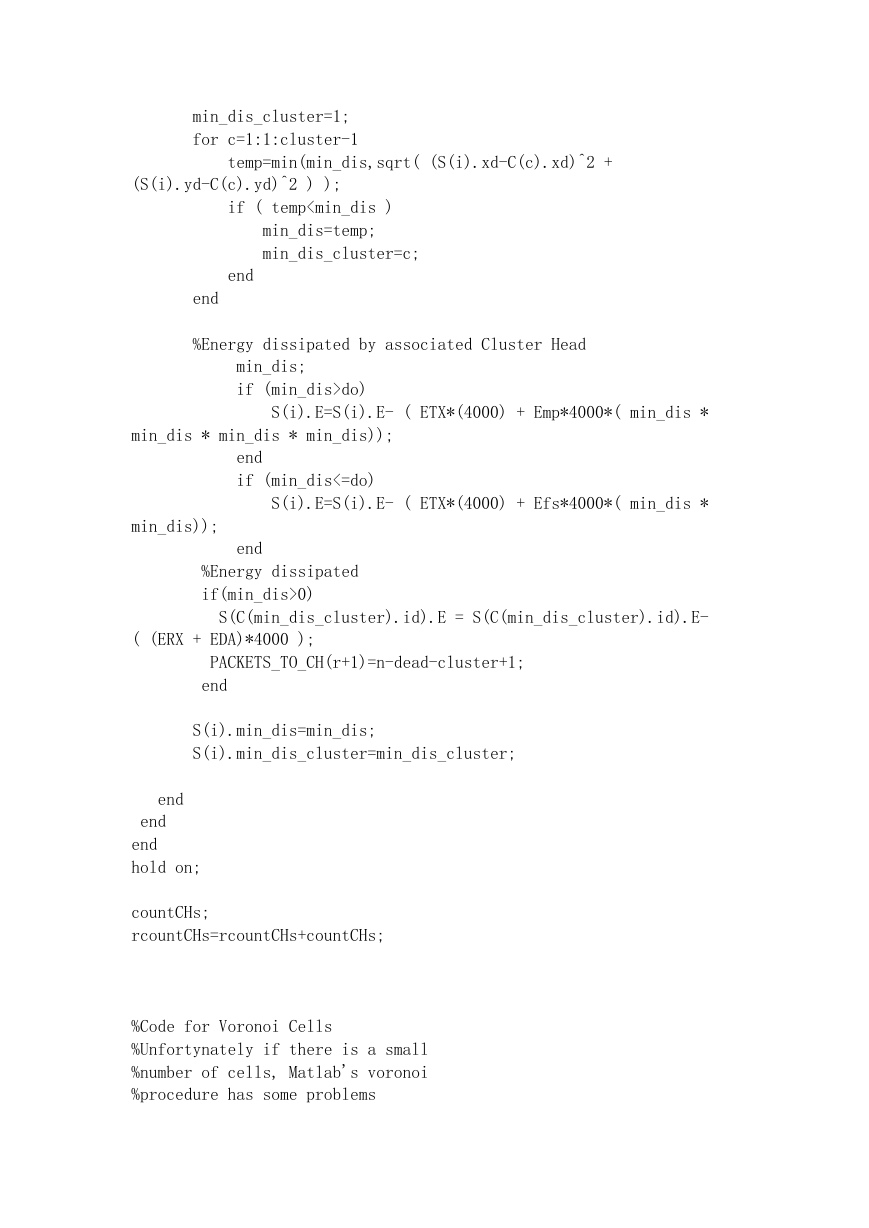
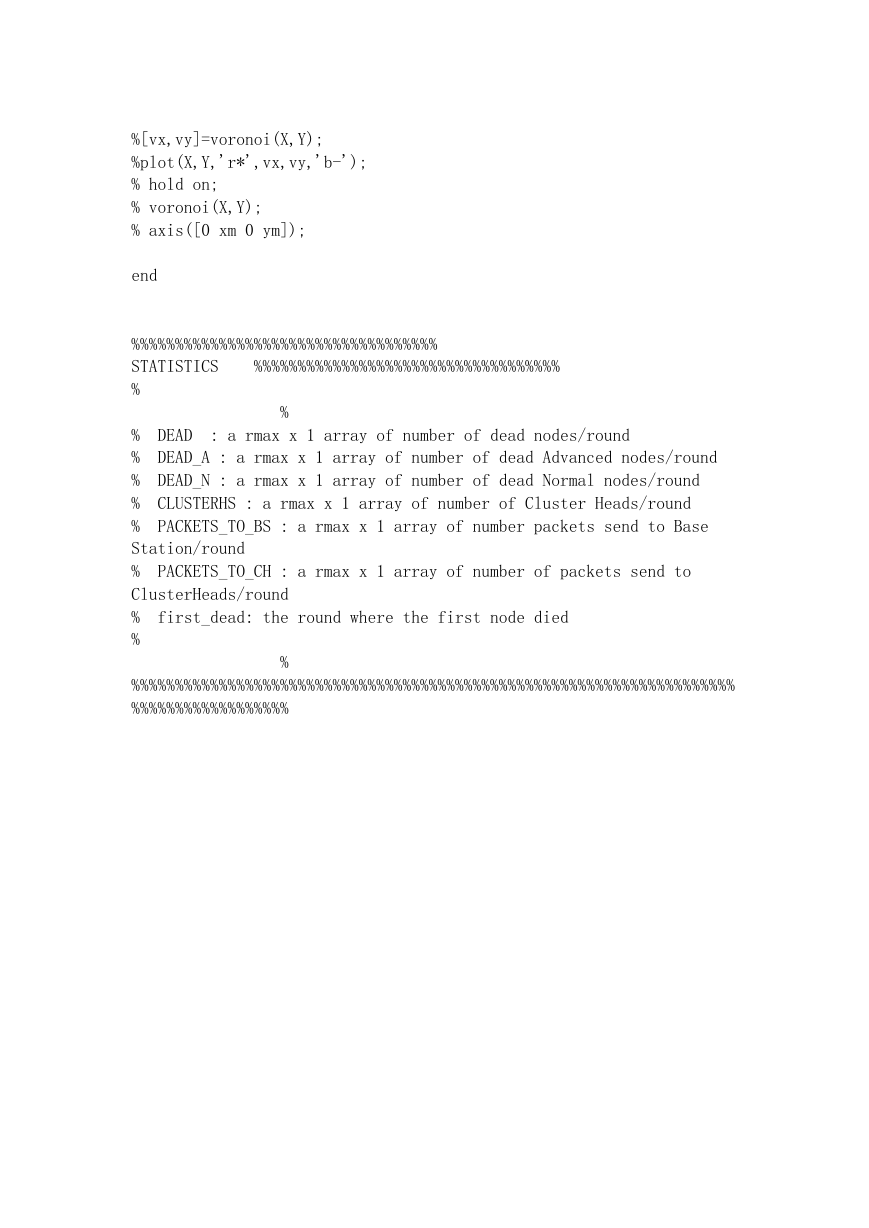








 2023年江西萍乡中考道德与法治真题及答案.doc
2023年江西萍乡中考道德与法治真题及答案.doc 2012年重庆南川中考生物真题及答案.doc
2012年重庆南川中考生物真题及答案.doc 2013年江西师范大学地理学综合及文艺理论基础考研真题.doc
2013年江西师范大学地理学综合及文艺理论基础考研真题.doc 2020年四川甘孜小升初语文真题及答案I卷.doc
2020年四川甘孜小升初语文真题及答案I卷.doc 2020年注册岩土工程师专业基础考试真题及答案.doc
2020年注册岩土工程师专业基础考试真题及答案.doc 2023-2024学年福建省厦门市九年级上学期数学月考试题及答案.doc
2023-2024学年福建省厦门市九年级上学期数学月考试题及答案.doc 2021-2022学年辽宁省沈阳市大东区九年级上学期语文期末试题及答案.doc
2021-2022学年辽宁省沈阳市大东区九年级上学期语文期末试题及答案.doc 2022-2023学年北京东城区初三第一学期物理期末试卷及答案.doc
2022-2023学年北京东城区初三第一学期物理期末试卷及答案.doc 2018上半年江西教师资格初中地理学科知识与教学能力真题及答案.doc
2018上半年江西教师资格初中地理学科知识与教学能力真题及答案.doc 2012年河北国家公务员申论考试真题及答案-省级.doc
2012年河北国家公务员申论考试真题及答案-省级.doc 2020-2021学年江苏省扬州市江都区邵樊片九年级上学期数学第一次质量检测试题及答案.doc
2020-2021学年江苏省扬州市江都区邵樊片九年级上学期数学第一次质量检测试题及答案.doc 2022下半年黑龙江教师资格证中学综合素质真题及答案.doc
2022下半年黑龙江教师资格证中学综合素质真题及答案.doc